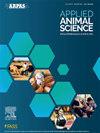Milk feeding through an open bucket or nipple bucket: Performance and behavior of dairy calves
IF 1.5
Q3 AGRICULTURE, DAIRY & ANIMAL SCIENCE
引用次数: 0
Abstract
Objective
This study compared the performance and behavior of dairy calves using 2 different milk feeding methods: open bucket and nipple bucket.
Materials and Methods
Thirty newborn Holstein calves were blocked and randomly assigned to 1 of 2 milk feeding methods: (1) open bucket (n = 15) or (2) nipple bucket (n = 15). Calves were individually housed with ad libitum access to water and pelleted starter. Calves were fed 6 L/d of whole milk divided into 2 meals for 8 wk of life. Starter intake was recorded daily. Body weight and metabolic parameters were recorded weekly. Calf behavior was recorded weekly from wk 2 to 8 of life.
Results and Discussion
All calves consumed their al- located milk; however, the nipple bucket feeding decreased starter intake and consequently total DMI (1,067.8 and 964.3 ± 27.08 [SEM] g/d), with no effect on ADG or BW. The average fecal score was greater for calves fed with an open bucket, reflecting more fluid feces (1.85 and 1.59 ± 0.071). Calves fed with a nipple bucket presented greater glucose concentration levels 2 h after feeding (121.1 and 131.5 ± 3.95 mg/dL), but the protein, albumin, and he- matocrit were not affected. Milk intake speed was great- er for calves fed with a nipple bucket (1.86 and 5.33 ± 0.233, min/3 L). Calves fed with a nipple bucket spent less time eating starter (3.71 and 1.92 ± 0.311, min/4 h) and performing non-nutritive oral behavior (1.09 and 0.58 ± 0.212, min/4 h); however, they spent more time consum- ing milk (7.01 ± 0.224, min/4 h).
Implications and Applications
The milk feeding method has a short-term positive influence on calves’ pre- weaning behavior, although it does not affect performance.
通过开放式桶或乳头桶喂奶:小牛的性能和行为
目的比较开桶和乳头桶两种喂奶方式对犊牛生产性能和行为的影响。材料与方法将30头新生荷斯坦犊牛封闭,随机分为两种喂奶方式:(1)开桶(n = 15)和(2)乳头桶(n = 15)。犊牛单独饲养,可自由取水和饲喂颗粒状发酵剂。犊牛每天饲喂6升全脂牛奶,分两餐饲喂,持续8周。每天记录起始剂的摄入量。每周记录体重和代谢参数。从第2周到第8周,每周记录小牛的行为。结果与讨论所有犊牛均消耗了原位乳汁;然而,乳头桶喂养减少了起动器的摄入量,从而减少了总DMI(1,067.8和964.3±27.08 [SEM] g/d),对平均日增重和体重没有影响。开桶喂养的犊牛粪便平均得分更高,反映出更多的流质粪便(1.85和1.59±0.071)。饲喂乳头桶后2 h,犊牛体内葡萄糖浓度升高(121.1和131.5±3.95 mg/dL),但对蛋白质、白蛋白和红细胞压积没有影响。乳头桶喂养的犊牛吸乳速度显著(1.86和5.33±0.233,min/3 L)。犊牛进食发酵剂的时间(分别为3.71和1.92±0.311,min/4 h)和非营养性口腔行为的时间(分别为1.09和0.58±0.212,min/4 h)较少;然而,它们消耗牛奶的时间更长(7.01±0.224,min/4 h)。启示与应用乳喂养方式对犊牛断奶前行为有短期的积极影响,但不影响生产性能。
本文章由计算机程序翻译,如有差异,请以英文原文为准。
求助全文
约1分钟内获得全文
求助全文

 求助内容:
求助内容: 应助结果提醒方式:
应助结果提醒方式:


